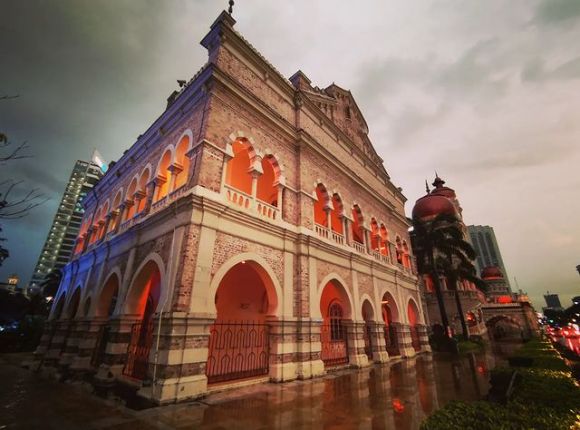A living symbol of Malaysia’s story
Just before midnight on 30 August 1957, crowds gathered on the field now called Dataran Merdeka. As the clock on the copper-domed tower struck, the Union Jack was lowered and the Malayan flag rose for the first time—a defining moment witnessed under the gaze of the Sultan Abdul Samad Building. Since then, this graceful façade has framed national parades, celebrations, and the city’s collective memory.

What makes it special
Fronting Jalan Raja and the Royal Selangor Club, the building is the showpiece of KL’s historic core. Its Indo-Saracenic / Neo-Mughal vocabulary—striped “blood-and-bandage” brickwork, scalloped arches, and bulbous copper domes—culminates in a 41-metre clocktower that chimes the hour. The long façade runs more than 130 m, creating one of the city’s most photogenic skylines.



A quick history (1894—today)
- Built: Foundation stone laid in 1894; completed and inaugurated in 1897 as the “Government Offices” for the British colonial administration. It was renamed in 1974 to honour Sultan Abdul Samad of Selangor, who reigned when construction began.
- Architects & design: Credited to A.C. Norman, with major design work by R. A. J. Bidwell and contributions by A. B. Hubback (who later designed KL’s railway station). The final scheme adopted the Mughal/Indo-Saracenic style preferred by the Public Works Department.
- Courts era: From the late 1970s the building housed Malaysia’s superior courts. In 2003, the Federal Court and Court of Appeal moved to the new Palace of Justice in Putrajaya.
- Heritage status: Gazetted as National Heritage in 2007 under the National Heritage Act.
Architecture at a glance
The plan forms a long, arcaded frontage facing the padang (lawn) with deep verandas that temper KL’s tropical heat. Three principal domes—two over stair towers flanking the centre and one atop the clocktower—are clad in polished copper that glows at golden hour and after dark under programmable LEDs installed in recent refurbishments. Look for the alternating courses of red brick and white plaster that give the façade its striped character.
Nearby highlights (walking distance)
- Dataran Merdeka – The historic field and ~95 m flagpole, among the world’s tallest, where the flag was first raised.
- Masjid Jamek – KL’s early mosque at the confluence of the Klang and Gombak rivers. The riverside “Blue Pool” light installation makes a great evening stroll.
- KL City Gallery & Central Market – Exhibitions, souvenirs, and heritage architecture a short walk away.
Why it matters
Beyond postcard beauty, the Sultan Abdul Samad Building is an architectural witness to KL’s evolution—from a colonial administration hub to a modern capital. It anchors the city’s narrative at the very spot where independence was first proclaimed to the public, and it continues to host national ceremonies that bind Malaysians together. For visitors, it’s both a photo stop and a place to feel the cadence of Malaysian history in the heart of the city.




